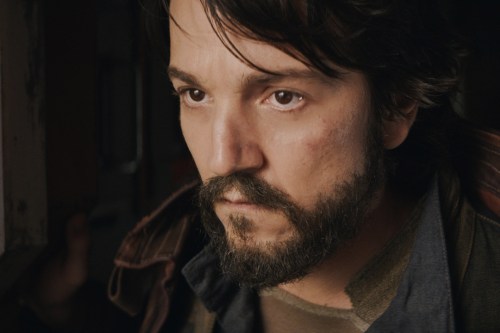
When Andor premiered one year ago this week, the general response to its first three episodes, which all dropped on Disney+ at the same time, was … interesting. While everyone seemed to welcome the Rogue One prequel with open arms and positive reviews, some were quick to express their concerns over the show’s pace. On the one hand, it’s not hard to see why. Andor‘s first three installments essentially serve as both the series’ inciting incident and its prologue.
The show’s opening chapters split their time between flashbacks to Cassian Andor’s (Diego Luna) traumatic childhood on the war-torn planet of Kenari and the present-day fallout of his impulsive decision to kill a pair of Imperial-adjacent officials. It isn’t until the end of Andor’s third episode that his backstory has been fully fleshed out and he’s actually left his adoptive planet of Ferrix with Luthen Rael (Stellan Skarsgård), the rebel leader who will jumpstart Cassian’s own radicalization. On paper, that might make it seem very little happens across Andor’s first three episodes.
One year later, however, it’s startling to look back at the TV series’ first few installments and realize just how quickly and efficiently they do their job. Andor’s premiere, in particular, not only perfectly sets up the 11 episodes that follow it, but it also subtly yet forcefully establishes the series’ unique tone, story, and characters. In 2022, Andor immediately pushed viewers headfirst into a kind of Star Wars story unlike any they’d seen before — and it fundamentally changed the franchise forever.
In its opening minutes, Andor follows its eponymous protagonist as he sneaks into a brothel, inquires about the possible whereabouts of his sister, ends up in a tunnel with a pair of brutish corporate officers, and is ultimately forced to kill them both. Narratively, it’s the kind of opening you’d see in a 1940s black-and-white noir thriller, and thanks to the constant downpour of rain that accompanies its exterior shots, it even looks and sounds a little like those films. The entire sequence boasts a steampunk sci-fi aesthetic that would make more sense in a Blade Runner sequel than a Star Wars show.
The rest of the episode is comprised of hushed alleyway conversations and meetings between corporate blowhards. No one, at any point, wields a lightsaber, mentions Emperor Palpatine’s name, or talks about the Sith and the Jedi. One of the episode’s most memorable scenes, in fact, revolves around a monologue given by a company boss to his employee about how Cassian’s murder of two of their workers ultimately reflects more poorly on their company than anything else — and how the entire incident should be covered up. It’s a scene unlike any other featured in a Star Wars film or TV show before, and it’s one that firmly grounds Andor’s story in a world of behind-the-scene politics, corporate machinations, and desperate power grabs.
While it’s set in the same universe as Return of the Jedi, Andor is not a space opera. On the contrary, there’s nothing classically operatic about it. It contains no glowing sword fights, displays of supernatural power, or debates about the moral state of the galaxy. It features nothing more than an assortment of characters doing their best to carve out a place for themselves in a world that is being systematically crushed by the iron fist of tyranny. Even after Luthen shows up and Andor’s first conflict reaches a point of no return, the series never goes bigger than it should. The moments of victory throughout Andor season 1 are, with a few exceptions, minor rebellions.
The series is one of the rare franchise efforts that actually earns the label “grounded.” From the moment it begins to the moment it ends, Andor is concerned only with what’s happening on the literal streets of Star Wars’ massive fictional galaxy. Brick by brick, its first three episodes set up and flesh out the show’s world-within-a-world. In doing so, they make Andor’s greater fictional universe feel more real and alive than any other Star Wars title in recent memory. Even more importantly, the series adds richer humanity and specificity to the tug-of-war between freedom and oppression that has been at the center of its franchise from the very beginning.
A stunning number of Disney+’s Marvel and Star Wars shows have done a disservice to their greater franchises, rather than the other way around. Andor is the rare exception to that growing rule, though. The series not only meets the standards set by its franchise’s greatest hits, but it does so while also expanding what stories the Star Wars franchise can tell onscreen. Not every movie or TV show set in a galaxy far, far away needs to feel beholden to the greater forces at work within it. Some can focus, instead, on the corporate stooges, fledgling fascists, freethinking rebels, and wronged civilians that populate it. Andor does that, which is why it made a genuine mark when it premiered last year.
The series’ first season isn’t just entertaining and fun, it’s also a genuinely fresh change of pace from so much of what’s come before (and after) it. Andor was — and still is — a shot in the arm of a franchise that has, for many years now, felt like it was running on life support.
Andor season 1 is streaming now on Disney+.
Editors' Recommendations
- 5 things we need to see in The Mandalorian & Grogu Star Wars movie
- The Acolyte’s first trailer embraces the Dark Side of Star Wars
- 20 years ago, Spider-Man swung onto MTV and changed the Marvel superhero forever
- Did Andor ruin Ahsoka, and maybe the entire Star Wars franchise, by being too good?
- 3 things we learned from the new trailer for Ahsoka